Description
Quick, economical and environmentally-friendly recipes for homemade deodorant.
Sommaire
Sommaire
- 1 Description
- 2 Sommaire
- 3 Introduction
- 4 Video d'introduction
- 5 Étape 1 - Details of ingredients
- 6 Étape 2 - Fabrication des déodorants à base d'huile de coco
- 7 Étape 3 - Fabrication du déodorant à base de bicarbonate et d'eau
- 8 Étape 4 - Fabrication du déodorant à base de vinaigre et d'eau
- 9 Étape 5 - Fabrication du déodorant roll-on
- 10 Notes et références
- 11 Commentaires
Introduction
Deodorants are products that many of us use on a daily basis. But industrial deodorants are increasingly controversial. The reason they are regularly singled out for criticism is that most of them contain chemical substances, some of which are potentially carcinogenic, allergenic or the cause of hormonal disorders. Don't hesitate to visit this consumer site to find out how the deodorant you are currently using is rated.
Among the high-risk chemical compounds, two families are particularly controversial: aluminium salts and parabens.
- Aluminium chlorohydrate: this is the name given to the aluminium salts in your deodorant formula. These micro-particles have the property of closing the pores through which sweat flows, and therefore "'stopping the production of perspiration'". Apart from the fact that blocking this phenomenon, and therefore preventing the body's thermal self-regulation, is '"dangerous'", aluminium salts have been suspected by several studies of causing breast cancer.
- parabens are the preservatives added to most cosmetic, pharmaceutical and industrial products. Studies have been underway for years to verify their harmful effects on the skin and their possible involvement in the development of breast cancer, due to their oestrogenic properties (endocrine disruptors).
If armpit odour is sometimes unpleasant, it's because these "folds" are a particularly favourable environment for the development of bacteria, which are responsible for these odours. Rather than blocking perspiration, it's better to prevent '"the development of these bacteria'" by using natural antibacterial products.
This tutorial gives you 5 healthy, practical, effective, economical and environmentally-friendly recipes for making your own homemade deodorant.
Solid versions:'
- Very economical, containing just 3 ingredients. Its only drawback is that it becomes liquid above 25°C (coconut oil) and tends to go out of phase if not kept in a cool place. At home, it may be worth getting into the habit of keeping it in a cool place.
- Same base as above, to which we add a 4th ingredient, beeswax (beeswax or vegetable wax). As it doesn't melt below 63°C, it allows the deodorant to stay put even when it's very hot.
Liquid versions (spray, roll or drops):
- Economical, local and minimalist (2 ingredients) based on bicarbonate and water
- Equally interesting, based on vinegar and water
- Semi-liquid recipe suitable for roll-ons (3 ingredients)
Youtube
Matériaux
Deodorant balsam (Winter- liquid above 25°C)
- 4 tablespoons / 50g coconut oil
- 2 tbsp / 25g sodium bicarbonate (as fine as possible)
- 2 tbsp / 25g cornstarch or arrowroot
- 10 drops of palmarosa essential oil
Solid deodorant (Summer)
- 3 tablespoons / 40g coconut oil
- 10g beeswax or 5g candelilla wax)
- 2 tbsp / 25g sodium bicarbonate (as fine as possible)
- 2 tablespoons / 25g cornstarch or arrowroot
- 10 drops of palmarosa essential oil
For an even more moisturising solid deodorant, replace the 3 tablespoons of coconut oil with 2 tablespoons of coconut oil and 1 tablespoon of shea butter.
Bicarbonate liquid deodorant
- Approximately 1/8th the volume of the bicarbonate spray bottle
- Water to top it off
- Optional: 4-8 drops of tea-tree or palmarosa essential oil
Vinegar liquid deodorant
- 50% by volume cider vinegar (or 25% white vinegar)
- 50% water by volume (or 75% water)
- Optional: 4-8 drops of tea-tree or palmarosa essential oil
Roll-on deodorant
- 1 teaspoon very fine bicarbonate of soda
- 1/2 teaspoon clay
- 1 pinch cornflour or guar gum (for the gel effect)
- 50% lime water
- 50% water
- Optional: 4-8 drops of tea-tree or palmarosa essential oil
Outils
- Glass jars for storing ingredients
- Salad bowl for mixing
- Soup spoon
- Coffee spoon
- Small glass jar for storing deodorant
- Scale
Étape 1 - Details of ingredients
- Food-grade sodium bicarbonate : Used here for its deodorising action, it can be used for a multitude of purposes (cleaning product, deodoriser, heartburn remover, teeth whitener, etc.). Made from limestone and salt. May cause irritation in some people. Can be replaced with white clay in this case. Cost ~3-4 euros/kg
- Cider vinegar or white vinegar : used as a deodorant. Has the ability to remove existing odours and reduce the strength of odour-producing bacteria.
- Corn starch or arrow-root (= maranta rhizome starch): these are two natural absorbents. They are also used to bind the product.
- Coconut oil: Used here for its moisturising and antibacterial properties.
- Tea Tree essential oil: used for its antibacterial properties and strong odour to delay and then mask the "bad smells" of perspiration.
- Huile essentielle de Palmarosa : À favoriser pour ses propriétés antibactérienne et antifongique.
- Cire d'abeille : Utilisé à la fois pour ses propriétés hydrophobes et antibactériennes, sa haute température de fusion (63°C) permet au déodorant de rester solide en toute circonstance.
Étape 2 - Fabrication des déodorants à base d'huile de coco
Déodorant baume (hiver) :
- Ajouter l'huile de coco liquide (préalablement fondue près d'une source de chaleur si besoin) au bicarbonate de sodium et à la fécule. Versez 10 gouttes d'huile essentielle de palmarosa.
- Bien mélanger le tout pour le rendre bien homogène.
- Couler le tout dans un petit pot/contenant en verre.
- Mettre le tout au réfrigérateur pour qu'il se fige.
Conserver à température ambiante. Appliquer avec le doigt sous les aisselles.
Étape 3 - Fabrication du déodorant à base de bicarbonate et d'eau
Prendre un petit format de vaporisateur permet de garder à portée de main toute la journée le déodorant en cas de besoins.
- Dissoudre un peu de bicarbonate dans l'eau. Attention à ne pas atteindre la saturation (limite où le bicarbonate ne se dissout plus) car la recristalisation risque de boucher le pulvérisateur. Si jamais vous atteignez ce cap, rajoutez un peu d'eau.
- Compléter le volume du pulvérisateur avec ce liquide
- ajouter en option 4-8 gouttes d'huile essentielle de tea tree ou palmarosa (ou autre suivant vos préférences). Pour une meilleure répartition de l'huile essentielle on peut ajouter un lichette d'alcool (qui servira de liant, les huille essentielles n'étant pas miscibles dans l'eau)
Pour parfumer vous pouvez remplacer l'eau par de l'hydrolat
Bien secouer avant utilisation.
Conservation plusieures semaines/mois sans besoin de frigo.
Étape 4 - Fabrication du déodorant à base de vinaigre et d'eau
Prendre un petit format de vaporisateur permet de garder à portée de main toute la journée le déodorant en cas de besoins.
- Verser dans un flacon 50% d'eau et 50% de vinaigre de cidre
- OU verser 25% de vinaigre blanc et 75% de volume en eau
- ajouter en option 4-8 gouttes d'huile essentielle de tea tree ou palmarosa (ou autre suivant vos préférences).
Pour parfumer vous pouvez remplacer l'eau par de l'hydrolat.
Attention, la présence d'acide et d'alcool du vinaigre peut irriter après rasage ou épilation.
Conservation plusieures semaines/mois sans besoin de frigo.
Étape 5 - Fabrication du déodorant roll-on
Dans un petit bol mélanger les ingrédients :
- 1 càc de bicarbonate très fin
- 1/2 càc d'argile
- 1 pincée de maïzena ou gomme guar
- En option 2 gouttes d'huile essentielle
- après avoir mélangé les ingrédients secs ajouter selon le volume du roll, 50% d'eau et 50% d'eau de chaux.
Bien agiter avant utilisation.
Conservation plusieures semaines/mois sans besoin de frigo.
Notes et références
-Etude sur les risques de sels d'aluminium : https://www.ncbi.nlm.nih.gov/pmc/articles/PMC5514401/
- Dossier santé sur les déodorants et autres recettes : https://amelioretasante.com/comment-faire-un-deodorant-naturel/
- Huile de coco, les dessous de la récolte: https://lacoquetteethique.com/protection-animale/huile-de-coco-ecologie-vegan/
Published
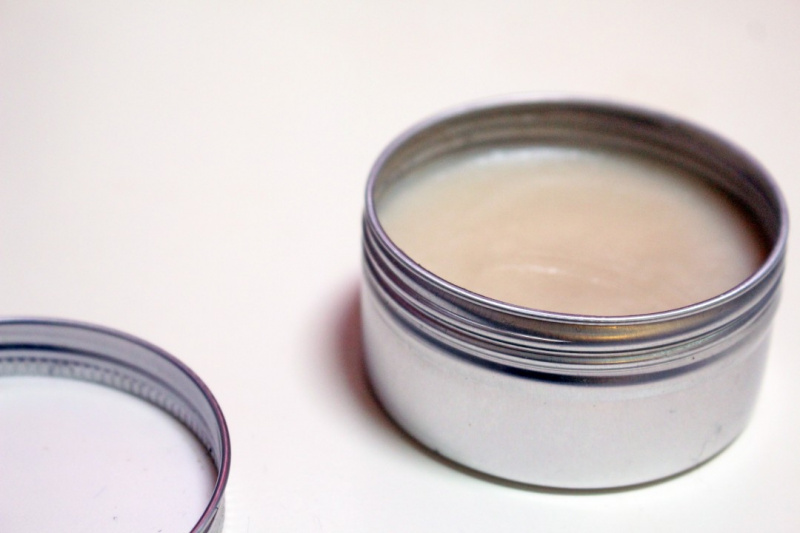
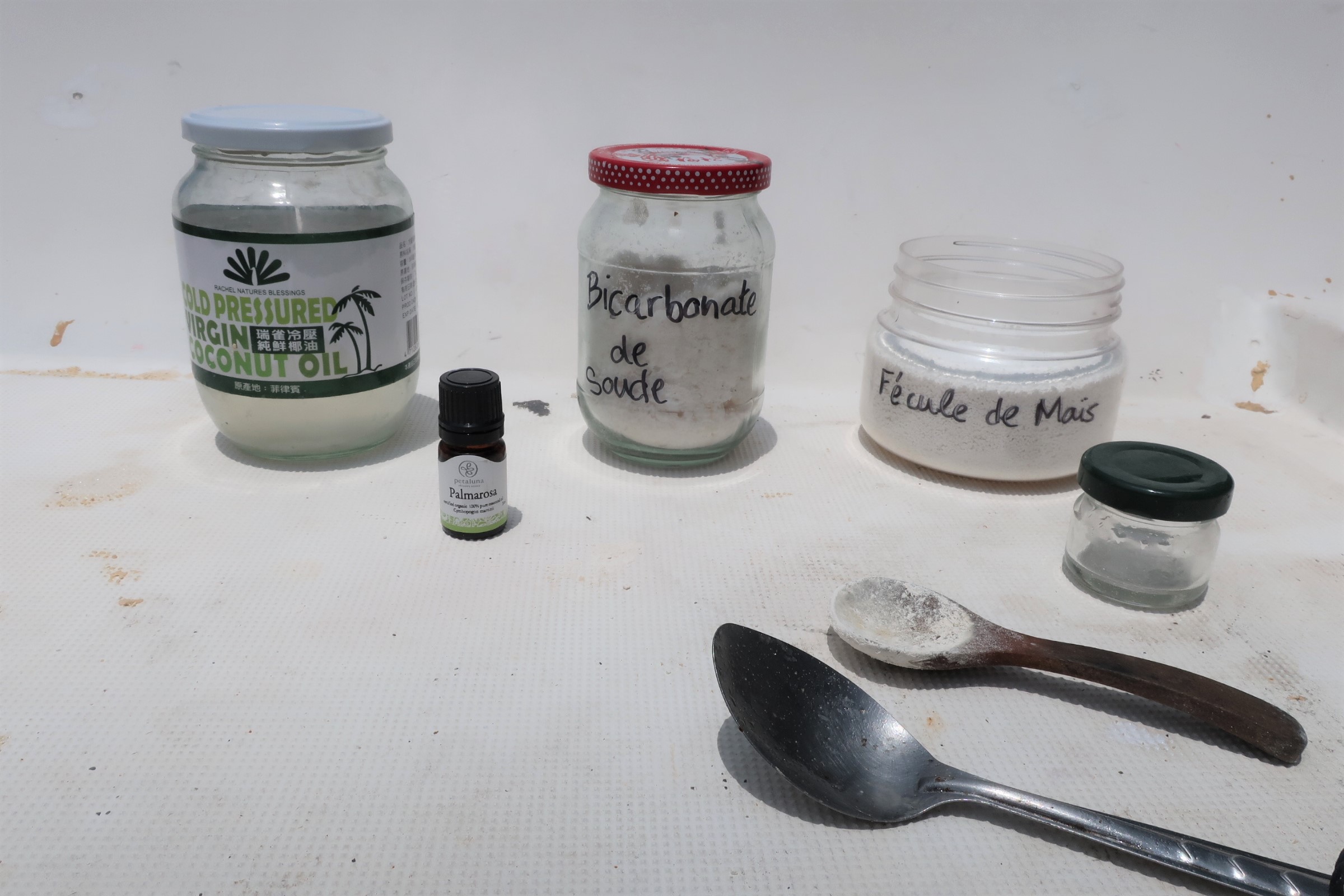
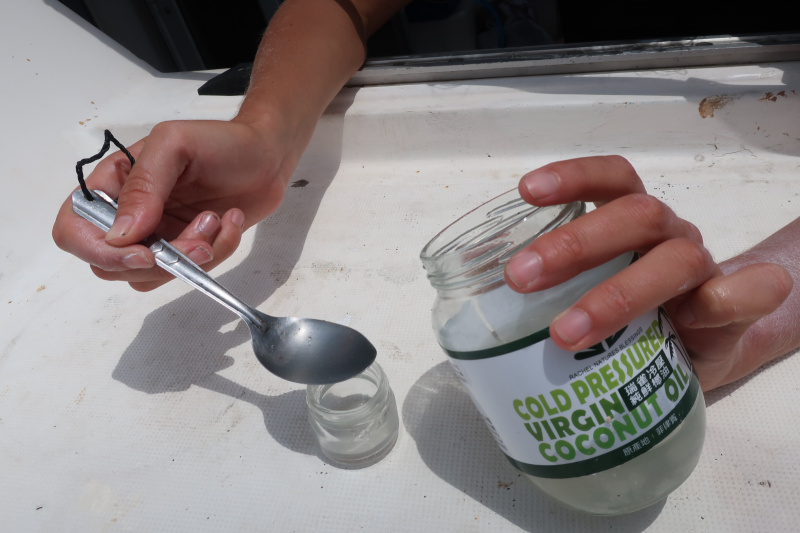
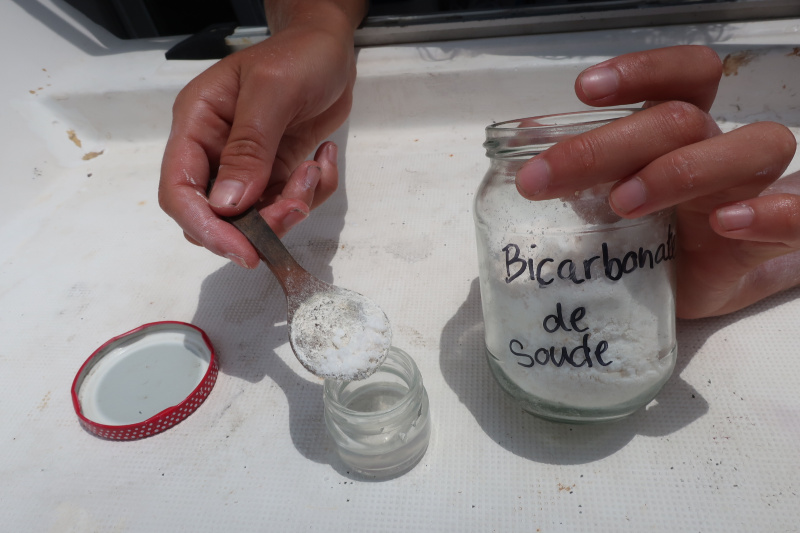
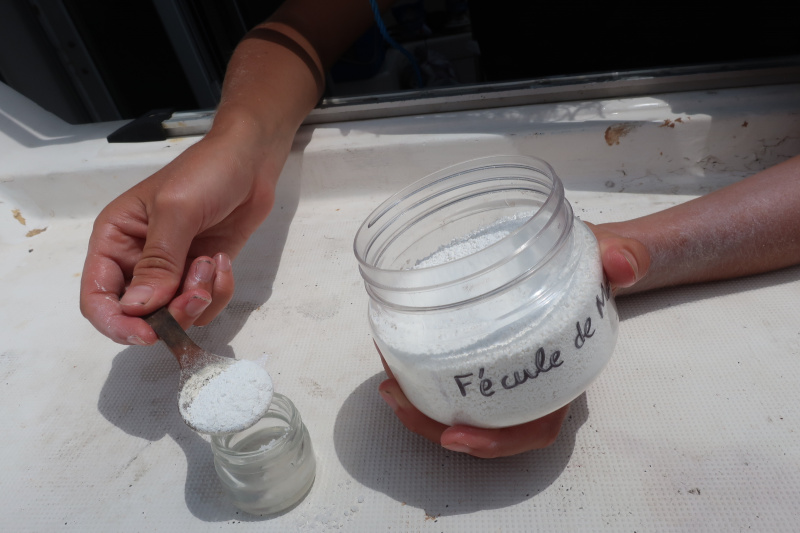
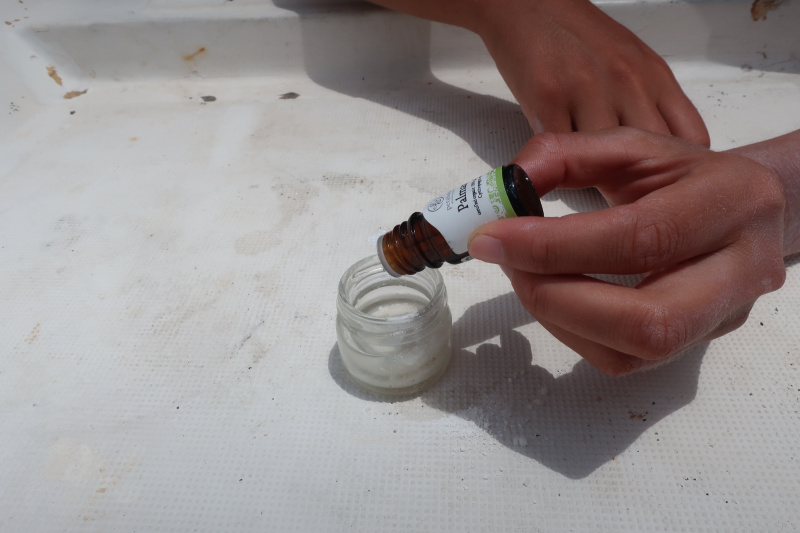
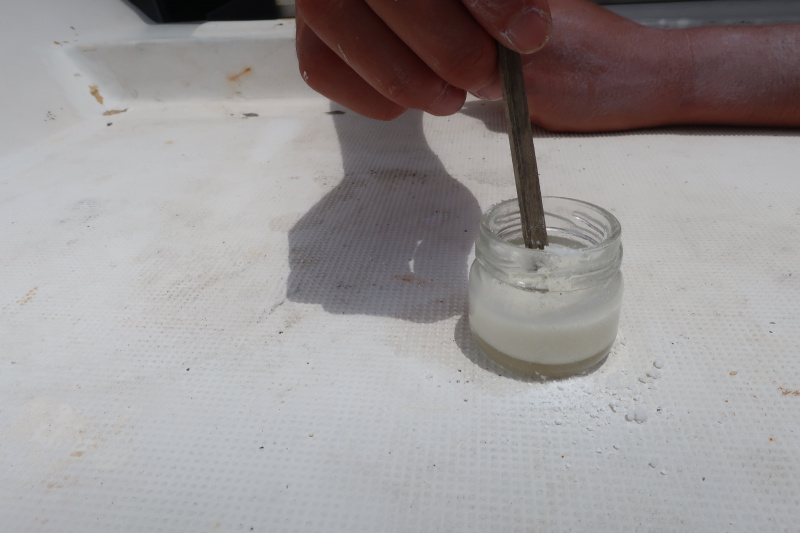
 Français
Français English
English Deutsch
Deutsch Español
Español Italiano
Italiano Português
Português